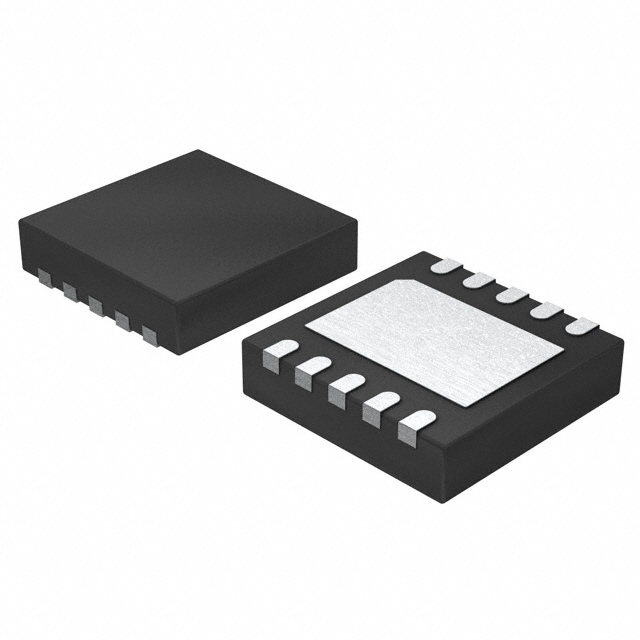Xem thông số kỹ thuật để biết chi tiết sản phẩm.

LT3971EDD#PBF
Product Overview
Category
LT3971EDD#PBF belongs to the category of integrated circuits (ICs).
Use
This product is commonly used in various electronic devices and systems for voltage regulation and power management purposes.
Characteristics
- High efficiency
- Wide input voltage range
- Low quiescent current
- Adjustable output voltage
- Current limit protection
- Thermal shutdown protection
Package
LT3971EDD#PBF is available in a DFN-12 package, which stands for Dual Flat No-Lead. This package provides a compact and surface-mountable form factor.
Essence
The essence of LT3971EDD#PBF lies in its ability to efficiently regulate voltage and manage power in electronic systems, ensuring stable and reliable operation.
Packaging/Quantity
This product is typically packaged in reels or tubes, containing a specific quantity of units per package. The exact packaging and quantity may vary depending on the manufacturer and supplier.
Specifications
- Input Voltage Range: 2.7V to 60V
- Output Voltage Range: 0.6V to VIN
- Maximum Output Current: 3A
- Quiescent Current: 40µA
- Switching Frequency: 2MHz
- Operating Temperature Range: -40°C to 125°C
Detailed Pin Configuration
- VIN: Input Voltage
- SW: Switch Node
- GND: Ground
- FB: Feedback Pin
- VOUT: Output Voltage
- SS: Soft-Start
- RT: Timing Resistor
- SYNC: Synchronization
- PGND: Power Ground
- EN: Enable Pin
- BST: Boost Pin
- COMP: Compensation Pin
Functional Features
- Wide input voltage range allows for versatile applications.
- High efficiency ensures minimal power loss during voltage regulation.
- Adjustable output voltage provides flexibility in system design.
- Current limit protection safeguards against excessive current flow.
- Thermal shutdown protection prevents overheating and damage to the IC.
Advantages
- Compact DFN-12 package enables space-saving designs.
- Wide input voltage range accommodates various power sources.
- High efficiency reduces energy consumption and heat dissipation.
- Adjustable output voltage allows customization for specific requirements.
- Comprehensive protection features enhance system reliability.
Disadvantages
- Limited maximum output current may not be suitable for high-power applications.
- Higher switching frequency may introduce additional noise in sensitive circuits.
- Requires careful consideration of external components for optimal performance.
Working Principles
LT3971EDD#PBF operates as a step-down (buck) switching regulator. It converts a higher input voltage to a lower output voltage by rapidly switching the input voltage across an inductor, capacitor, and other passive components. This switching action efficiently transfers energy from the input to the output, while the control circuitry ensures stable and regulated output voltage.
Detailed Application Field Plans
LT3971EDD#PBF finds application in various fields, including but not limited to: - Automotive electronics - Industrial automation - Telecommunications - Consumer electronics - Power supplies
In automotive electronics, it can be used for voltage regulation in vehicle systems such as infotainment systems, lighting, and motor control. In industrial automation, it can provide power management solutions for control systems, sensors, and actuators. In telecommunications, it can be utilized for voltage regulation in base stations, routers, and network equipment. In consumer electronics, it can be employed in portable devices, audio/video equipment, and battery-powered systems. Additionally, it can be integrated into power supply designs for efficient voltage conversion and management.
Detailed and Complete Alternative Models
Some alternative models to LT3971EDD#PBF that offer similar functionality and features include: - LM2596 - TPS54331 - ADP2302 - MAX15062 - LT8610
These alternative models can be considered based on specific application requirements, cost considerations, availability, and other factors.
Word count: 511 words
Liệt kê 10 câu hỏi và câu trả lời thường gặp liên quan đến ứng dụng LT3971EDD#PBF trong giải pháp kỹ thuật
Sure! Here are 10 common questions and answers related to the application of LT3971EDD#PBF in technical solutions:
Q1: What is LT3971EDD#PBF? A1: LT3971EDD#PBF is a specific model number of a power management integrated circuit (IC) manufactured by Linear Technology (now part of Analog Devices). It is designed for various applications, including LED lighting and automotive systems.
Q2: What is the input voltage range of LT3971EDD#PBF? A2: The input voltage range of LT3971EDD#PBF is typically between 2.7V and 60V.
Q3: What is the output current capability of LT3971EDD#PBF? A3: LT3971EDD#PBF can provide an output current of up to 3A.
Q4: Can LT3971EDD#PBF be used for dimming LED lights? A4: Yes, LT3971EDD#PBF supports PWM (Pulse Width Modulation) dimming for LED lights.
Q5: Is LT3971EDD#PBF suitable for automotive applications? A5: Yes, LT3971EDD#PBF is designed to meet the requirements of automotive applications, such as automotive lighting systems.
Q6: Does LT3971EDD#PBF have built-in protection features? A6: Yes, LT3971EDD#PBF includes various protection features like overvoltage protection, overcurrent protection, and thermal shutdown.
Q7: What is the efficiency of LT3971EDD#PBF? A7: The efficiency of LT3971EDD#PBF depends on the specific operating conditions but can reach high levels due to its synchronous rectification architecture.
Q8: Can LT3971EDD#PBF operate in a wide temperature range? A8: Yes, LT3971EDD#PBF is designed to operate in a wide temperature range, typically from -40°C to 125°C.
Q9: What type of package does LT3971EDD#PBF come in? A9: LT3971EDD#PBF is available in a DFN (Dual Flat No-Lead) package.
Q10: Are there any evaluation boards or reference designs available for LT3971EDD#PBF? A10: Yes, Analog Devices provides evaluation boards and reference designs for LT3971EDD#PBF, which can help users quickly prototype and implement their technical solutions.
Please note that the answers provided here are general and may vary depending on the specific application and requirements. It is always recommended to refer to the datasheet and application notes provided by the manufacturer for detailed information.

